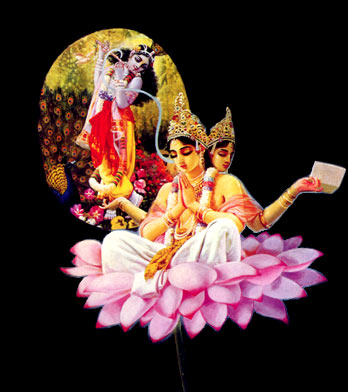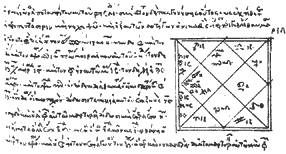The Fallacy of the
trans-Saturnian Planets
1 2 3 4
Shyamasundara Dasa
Copyright © 1997 - 2013
The following article is an excerpt from Foundational Topics in Vedic Astrology, and appeared in January, 1998 edition of The Astrological Magazine, Bangalore, India. It is aimed at the more advanced student and discusses some of the foundational topics of Vedic Astrology. After receiving this article Gayatri Devi, the daughter of Dr. B.V. Raman and present editor of Modern Astrology, wrote me and commented:
“Father [B.V. Raman] liked this article very much, it is exactly in keeping with his own opinions.”
Get the PDF version of this article in: English, French, German or Russian. Acrobat Reader required.
Abstract: Now that Vedic astrology has become popular in the West many Western trained astrologers are attempting to fuse the two systems or introduce Western concepts such as the trans-Saturnian planets into the Vedic system. Over the years some Indian astrologers have also attempted to introduce these planets into Vedic astrology. Such attemps are destructive to the internal philosophical consistency and logical structure of Vedic astrology. In addition it undermines the effectiveness of Jyotish while revealing a lack of understanding of the philosophical foundations of Vedic astrology, and the history of how trans-Saturnian planets were introduced. And, finally this practice demonstrates a general disrespect for the guru-parampara. If this erosion of Vedic astrology were to continue, then Jyotish would find itself in the same confused state that Western Astrology is in today, culminating in loss of accuracy, loss of respectability and ultimately the destruction of Jyotish as a Vedic discipline worthy of study.
Graha Versus Planet
There is a fundamental difference between the Vedic concept of graha and the Western use of Planets in astrology. Graha, by definition, is anything which has the power to seize, grasp or influence. In this case "seizing or influencing the destinies of men in a supernatural manner." The word for planet on the other hand is translated as loka in Sanskrit. Not all grahas are lokas, nor are all lokas grahas. In English, this means that the class of entities or objects which have divinatory significance includes planets, but not all planets have divinatory significance. (We are reminded however that while certain planets may be grahas, in a divinatory sense, they are not causal agents. They do not cause anything to happen. But as mantic grahas they do have the power to be used in a divinatory language to explain the will of God. Just as omens do not cause anything but are divine signs.)
In Vedic Astrology the ten major grahas are: The Ascendant, Sun, Moon, Mars, Mercury, Jupiter, Venus, Saturn, Rahu (North Node of the Moon) and Ketu (South Node of the Moon). Of these ten grahas the ascendant, Rahu and Ketu are not lokas or planets (in the traditional concept like Mercury or the Moon) but rather mathematical points calculated by the astrologer. Though not planets they are of great significance. Vedic astrology also has numerous upa-grahas (minor grahas) and kala-velas (sensitive points in time). Of these up-grahas and kala-velas, Mandi is considered most important and is especially used in Kerala. Mandi is definitely not a planet in the Western sense, but it is a graha.
Vedic Astrology is a limb of the Vedas and was revealed to Rishis from a higher source. Ultimately, Jyotish is revealed knowledge coming from Lord Sri Krsna, the Supreme Personality of Godhead. Thus, the traditional assignments of grahas is not trivial, meaningless or haphazard. We also note the Vedic distinction between the classification of graha (divinatory agent) and loka (planet).
Western Astrology entirely lacks the concept of graha; they are left only with planets. As a consequence, they assume that simply because something is floating "out there," whether it be a planet like Neptune, or Ganymede (a moon of Jupiter) or asteroids like Athena; in all cases they should be incorporated into the chart. We suggest that such an attitude creates an incomprehensible hodge-podge which further erodes the axiomatic basis of their school of astrology. (What about comets and meteors? While Vedic astrology doesn’t use asteriods in delineations, it does recognize and use comets and meteors, especially in Mundane astrology and nimitta.)
Pandora’s Box
Presently in Western astrology there is a great welter of confusion caused by the introduction of these "planets." It started with Neptune, Uranus and Pluto but once Pandora’s box was opened they could not stay the flood. Now there are eight Uranian planets (used by the Cosmo-biologists): Cupido, Hades, Zeus, Kronos, Apollon, Admetos, Vulcanus and Poseidon; these planets are not physical entities but fictional. And sixteen asteroids commonly used: Ceres, Pallas, Juno, Vesta, Psyche, Eros, Lilith, Toro, Sappho, Amor, Pandora, Icarus, Diana, Hidalog, Urania and Chiron. Some authors have written books on individual asteroids and their placement in the chart. Then there is Trans-Pluto, also known as Bacchus, it supposedly lies beyond the orbit of Pluto and (as of this writing 1994) has not been discovered yet! But some Western astrologers already delineate Bacchus’s meaning in charts and write books on it. If this assault on our Vedic sensibilities were not enough there is still more. A group of Western astrologers is in the process of cataloging about 2400 (!) other "less" important asteroids, calculating ephemerides for them, naming them and giving them meanings. Then there are those who advocate the Vertex (a point calculated by spherical geometry) and such points as the Galactic center. Soon in Western astrology the chart will be so crowded with detritus that it would be more meaningful to scatter a handful of confetti and try to read that. Is this what we want to happen to the discipline of Vedic Astrology?
In 1987-88 when I worked at MATRIX software developing the first professional Vedic astrology software I became very familiar with Western astrology in all its phases. MATRIX had the most sophisticated Western astrology software and those programs contained every conceivable technique known to Western astrology. Some were so bizarre that I was baffled how anyone could possibly take them seriously.
Since MATRIX was in the business of writing software they had to please all their clients and to do so they incorporated all techniques. I once asked the senior astrologer-programmers what methods they used from the welter of "stuff" that they programmed. They replied that they used only transits, not even Secondary Directions (progressed charts) or Solar Returns! Then I asked them if they used the gaggle of asteroid-cum-planets mentioned above. They replied in the negative. They suggested that only "kooks" went in for such things and it was not the domain of serious astrologers. But I countered by saying that if they accepted Neptune, Uranus and Pluto why stop there? Pandora’s box has been opened and pandemonium reigned. Many of the so called New Age astrologers who use all the confetti planets accuse the others of being "fuddy duddies" for their conservative views. If the serious Western Astrologers really want to be consistent they should also give up Neptune, Uranus and Pluto.
MATRIX Software was (is) at the cutting edge of Western Astrology and many famous Western Astrologers would often come and visit. There were also several experienced Western astrologers on the MATRIX staff. Yet with all this talent in Western astrology, it was a tribute to Vedic astrology that all those who sought out astrological advice came to me. When I asked why, my clients said that they didn’t feel that Western astrology described them properly, etc. This superiority of Vedic astrology rests on several factors one of which rejects trans-Saturnian planets.
Subscribe to our mailing list. And get our intermittent newsletter and updates to this site.
Gimmicks
One senior research astrologer at the AFA (American Federation of Astrologers), who prefers to remain anonymous for obvious reasons, once suggested to me that planets such as Neptune, Uranus and Pluto (what to speak of the confetti planets) were introduced as gimmicks by incompetent astrologers who could not properly read the existing horoscope. There seems to be much truth in what he said. Astrology is considered the most difficult material science, and reading a horoscope is no mean task. To decipher the meanings of the ten significators (ascendant, Sun, etc.) in the signs and houses taking into consideration all the rules of astrology is a major task even for the greatest minds. If one has not properly understood the meanings of these ten significators then the chart will present mysteries. To bolster the weaknesses in Western astrology (caused by a broken tradition, lack of philosophical basis, etc.) it seems that modern Western astrology keeps adding more and more gimmicks. But do these gimmicks really give more information? I think not, they just add to the confusion and loss of discipline.
A competent Vedic astrologer can understand all the features of a person’s life simply with the use of the ten significators. There are no mystery areas that require the introduction of ersatz grahas. Who is the better astrologer now by using Uranus, Neptune, Pluto, and the rest? Who, by using these extraneous planets, can claim to be a better astrologer than Parasara or Varaha Mihira? What to speak of these great Vedic astrologers there are many contemporary Vedic astrologers who can masterly delineate a horoscope without need of superfluous planets. Even by Western standards, who among the contemporary Tropical astrologers, by using trans-Saturnian planets, even approaches the expertise of Thrysallus or Bilballus, the court astrologers of the Ceasars (these two were before Ptolemy and thus siderealists). Or later Western astrologers such as Placidus de Titi, William Lilly or Morinus; none of whom used trans-Saturnian planets. In the realm of Mundane astrology, probably the most complex field in astrology, no Western astrologer has even come close to the accuracy of B.V. Raman whose reputation was built on his world predictions. B.V. Raman totally eschews trans-Saturnian planets. I am quite certain that any other qualified Vedic astrologer, can better explain a horoscope without using trans-Saturnian planets and astro-detritus.

